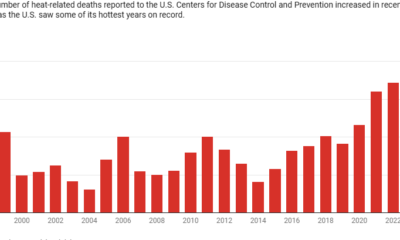cct-tracking
Eastern U.S. Faces Extended Onslaught of Scorching Heat Waves

Extreme heat continues to impact the Midwest and East Coast, marking the second consecutive day of dangerously high temperatures. Millions are under heat advisories as a June heat wave lingers across numerous states.
According to the National Weather Service, temperatures in the Chicago area soared to 80°F (26.6°C) by 7:30 a.m. Sunday. Forecasts predict heat indices reaching 100 to 105°F (37.7 to 40.5°C). Pittsburgh is also bracing for a heat index exceeding 105°F, while Columbus, Ohio, anticipates highs of 97°F (36°C) with a heat index around 104°F (40°C).
Philadelphia’s public health department declared a heat emergency starting Sunday and lasting until Wednesday evening. Essential services include directing residents to air-conditioned facilities and establishing a hotline for medical advice. Attendees at Sunday’s FIFA World Cup match will be permitted to bring a single 20-ounce water bottle to combat the oppressive heat.
In Cromwell, Connecticut, the heat index is projected to reach 105°F on Sunday, creating challenges for golfers during the final round of the Travelers Championship. Athletes across the country are feeling the effects; Cincinnati Reds shortstop Elly De La Cruz and Seattle Mariners pitcher Trent Thornton both fell ill while competing in extreme temperatures.
While Saturday recorded heat indices of 103°F in Chicago and 101°F in Madison, Wisconsin, Minneapolis experienced an unprecedented heat index of 106°F. The actual temperature there hit 96°F, breaking a record that stood since 1910.
Looking ahead, temperatures are expected to remain elevated into the week. New York City and Boston are forecast to see highs around 95°F (35°C) and near 100°F (37.7°C), respectively. Meanwhile, Washington, D.C., anticipates highs nearing 100°F on both Tuesday and Wednesday.
Meteorologists indicate that a heat dome—a high-pressure system that traps heat and humidity—is the root cause of these extreme conditions. Mark Gehring, a meteorologist with the National Weather Service, notes that while such heat isn’t unusual for summer, its extensive reach is exceptional.
“It’s basically everywhere east of the Rockies,” Gehring remarked, underscoring the widespread nature of the current heat wave.
Copyright 2025 Associated Press. All rights reserved. This material may not be published, broadcast, rewritten, or redistributed.


















